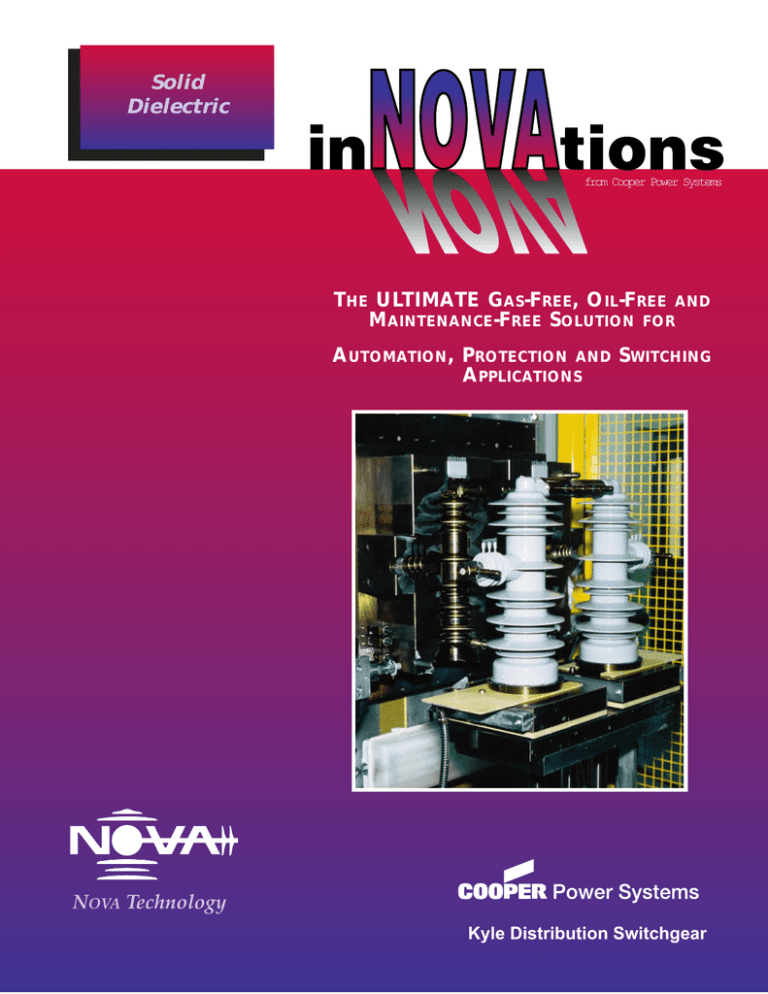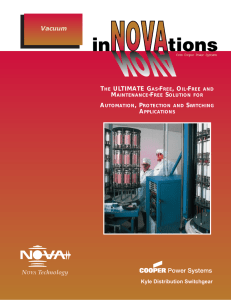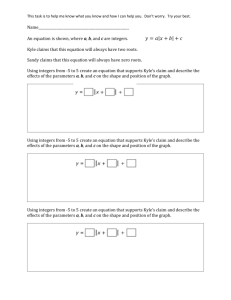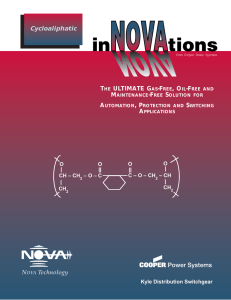N Technology Solid Dielectric
advertisement

Solid Dielectric from Cooper Power Systems THE ULTIMATE GAS-FREE, OIL-FREE AND MAINTENANCE-FREE SOLUTION FOR AUTOMATION, PROTECTION AND SWITCHING APPLICATIONS NOVA Technology Kyle Distribution Switchgear Solid Dielectric Axial-Magnetic Field Vacuum Interruption The Shape of Things to Come… The manufacturing process begins with the vacuum interrupter. Kyle’s NOVA vacuum interrupters utilize an advanced axial-magnetic field contact design. The relatively low heat produced by these interrupters, during an interruption, minimizes any possible interface problems between the vacuum interrupter and the encapsulation that could be caused by differences in coefficients of expansion. C ooper Power Systems, Kyle Distribution Switchgear introduces the revolutionary NOVA™ family of solid-insulated distribution switchgear products. Years of research, design and testing have culminated in the first-ever solid-insulated line of reclosers, switches, and sectionalizers. With over 50 years of design and manufacturing expertise, Kyle has combined solid cycloaliphatic-epoxy polymer-encapsulated vacuum interrupters with a reliable, lightweight, low-energy operating mechanism. NOVA represents a major commitment and investment in research and design, new facilities and process control equipment. High-Alumina Ceramic Designed for maximum life and long-term vacuum integrity. A state-of-the-art design completely replaces liquid and gas dielectric media. It is the maintenance-free alternative in distribution system protection. NOVA is the “shape of things to come.” Bellows Manufacturing Process Ensures Consistent Quality Contact Assembly Permits full stroke for contact separation without affecting vacuum seal. Copper chromium composite chosen for antiwelding and high current interrupting capabilities. A completely new manufacturing process used to achieve the operating performance and long life capabilities of the cycloaliphatic material, with machinery utilizing the latest technology, has been designed by Kyle Engineering and installed at the Kyle Distribution Switchgear plant. Manufacturing techniques have been developed that assure the highest quality of manufacture, with appropriate measuring and monitoring systems to ensure the integrity of the entire process and assembly. Contact Shield Kyle axial-magnetic field vacuum interrupter. Pre-Encapsulation Assembly Prior to molding, the interrupter is assembled with the appropriate contact rods and connections. A lowfriction, low-resistance connection between the moving contact conductor and the conducting arm is provided by a Multilam™ current exchange. With parts assembled, the vacuum interrupter is then ready for the encapsulation process, which is the most critical part of the entire manufacturing process. NOVA solid epoxy encapsulation facility. 2 Solid Dielectric Epoxy Mixing and Vacuum Degassing The cycloaliphatic material is a precisely-controlled mixture of an epoxy material and hardener. Each component is separately prepared prior to the mixing and molding. The materials are individually thin film vacuum degassed at an elevated temperature to provide a thorough degassing process. By removing all moisture, the mold results in a void-free, completely homogeneous material. Encapsulation Process The encapsulation utilizes an Automatic Pressure Gelation (APG) process, in which the vacuum interrupter and mold are preheated to about 150°C, higher than the temperature of the epoxy and the hardener. The APG process provides a fast curing time while ensuring the desired cross linking of the epoxy and hardener materials. Cycloaliphatic epoxy mixing and degassing system. Blow out sample used for quality assurance testing. Pressure relief vents assure void-free mold. Highest Quality Integrity Provided by Process Design: • Temperature: Inserts and mold are maintained at the same elevated temperature. This ensures that the epoxy, which is at a lower temperature, will cure from outside in, resulting in superior shrinkage control. • Pressure: Three atmospheres ensures the absence of shrinkage. • Void Control: Thin film vacuum degassing and elevated temperature ensures freedom of water vapor and trapped gases. Precisely mixed, vacuum degassed cycloaliphatic epoxy injected into mold under pressure. Cycloaliphatic epoxy molding process diagram. 3 Solid Dielectric The preheated vacuum interrupter is clamped between two halves of a preheated, highly polished, stainless steel mold. The epoxy and hardener are then mixed and injected at high pressure into the mold. After the epoxy gels, it is removed from the mold and is post-cured for about two hours and cooled in a two-stage tunnel oven. The first stage is run at an elevated temperature. The second stage provides a cooldown to normal room temperature. Post-curing tunnel oven. The operating rod cavity is designed to provide insulating strength greater than 125 kV BIL between the contact and ground potential as an extra customer safety feature. This cavity is then filled with nitrogen gas and sealed at the bottom with a rubber seal which also allows contact rod travel. Nitrogen is used to prevent ingress of any moisture or other contaminant into the operating rod cavity, thus ensuring the full dielectric withstand strength of the operating rod and cavity. Steel mold and clamping machine with 27 kV molded interrupters. Final Encapsulated Interrupter Assembly To complete the assembly, the operating rod is connected to the moving rod of the vacuum interrupter. The operating rod is also made of cycloaliphatic epoxy and provides the mechanical movement, as well as part of the insulation between the lower vacuum contact and the operating mechanism, which is at ground potential. 4 Solid Dielectric Encapsulated Interrupter Quality Testing After assembly, stringent testing is performed to ensure quality and performance. The entire assembly is x-rayed to check for any possible voids in the encapsulation and to verify proper overall alignment of the vacuum interrupter and connecting parts. Dielectric performance is then confirmed by means of a 60 Hz highpotential withstand test on the overall assembly. After molding, the final module is tested, verifying accuracy of the entire process, from the preparation and mixing of the polymer and hardener to the molding process itself (temperature, time, cooling). Kyle NOVA three-phase recloser. Each molded interrupter module has blowout holes that form a separate blowout Quality Assurance sample which allows each mold to be tested with a Differential Scanning Calorimeter (DSC). The samples are taken from the final molds on a statistical sampling basis and tested to determine the material’s glass transition temperature. A critical quality check, the glass transition temperature ensures that the process and temperature are always correct. Final Assembly The interrupters are assembled to the operating mechanism and subjected to standard production tests, which include mechanism operation under high, low, and normal operating voltages, overall phase resistance, and a 100-operation mechanical operations test. The switchgear is then ready for crating and shipment. Kyle Solid Insulation Leads Industry Installed Kyle NOVA three-phase recloser. Cooper Power Systems’ Kyle NOVA switchgear products (reclosers, switches, sectionalizers) incorporate a solid insulation system. All NOVA products utilize state-of-the-art design, materials, and manufacturing processes. Congruent with utilities’ maintenance-free philosophy, Kyle NOVA switchgear products provide extended life, reliable, and maintenance-free operation. 5 Solid Dielectric ©1998 Cooper Power Systems, Inc. Kyle® is a registered trademark of Cooper Industries, Inc. NOVA™ is a trademark of Cooper Industries, Inc. Multilam™ is a trademark of Multi-Contact USA Bulletin 98007 • February 1998 • New Issue P.O. Box 1640 Waukesha, WI 53187 USA www.cooperpower.com KTM 2/98






